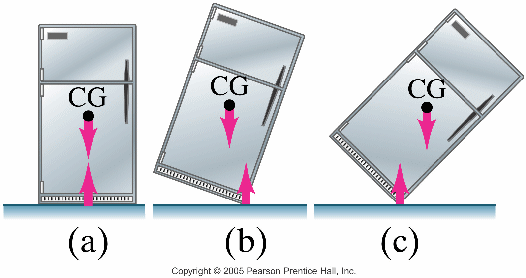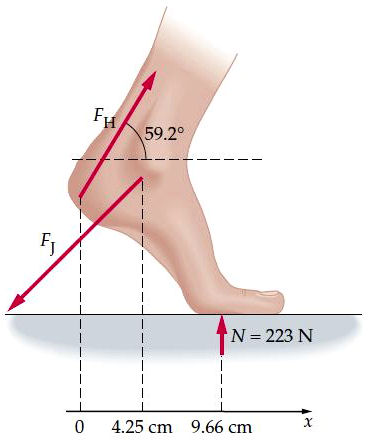Summary
- Rolling motion
- Rotational energy
- Moment of inertia
- Torque
- Reading Quiz
- Newton's second law
- derivation for rotation
- moment of inertia
Example #1
- torque & rotation applet
- net torque & acceleration applet

- Static equilibrium


- Stability & balance [optional]



Walker4e
Reading quiz What is the torque caused by the tension T about the elbow?

A. L T sin 40.0°
B. L T cos 40.0°
C. L T tan 40.0°
D. L T
Answer
sj6 10.38
A 0.50 m-radius, 100 kg potter's wheel freely rotates at 50 rev/min. The potter stops it in 6.0 s by pressing inwards on the rim with
70 N force. What is μk between potter and wheel?
A. 0.156
B. 0.227
C. 0.312
D. 0.533
Answer
Wlk4 11.37
The figure below shows the forces acting on a sprinter's foot just before she takes off
at the start of the race. Find the magnitude of the force exerted on the heel by the
Achilles tendon, FH, and the magnitude of the force exerted on
the foot at the ankle joint, FJ.

A. FH = 169 N, FJ = 507 N
B. FH = 446 N, FJ = 223 N
C. FH = 330 N, FJ = 534 N
D. FH = 884 N, FJ = 722 N
Answer
sj6 12.24
Two identical, uniform bricks of length L are stacked as shown. What is the maximum x without falling?
A. L
B. 3L/4
C. L/2
D. L/3

Answer
gc6 9.36
The Leaning Tower of Pisa is 55 m tall and about 7.0 m in diameter. The top is 4.5 m off center. How much farther can it lean
before it becomes unstable?

A. 1.0 m
B. 2.5 m
C. 3.5 m
D. 4.5 m
Answer
A. L T sin 40.0°
Only the component of the tension T that is perpendicular
to the moment arm L will produce a torque. That component is Ty, and it
is the side opposite to the angle, so Ty = Tsin 40°.

C. 0.312

C. FH = 330 N, FJ = 534 N


B. 3L/4
The center of mass of the first brick must be above the point of support,
and the center of mass of the two-brick combination
must also be above its point of support.
B. 2.5 m
The top would have to move one diameter in order to put the center gravity, assumed to be halfway
down, over the pivot point of one side of the base. It can therefore move 7.0 m − 4.5 m = 2.5 m further.





















